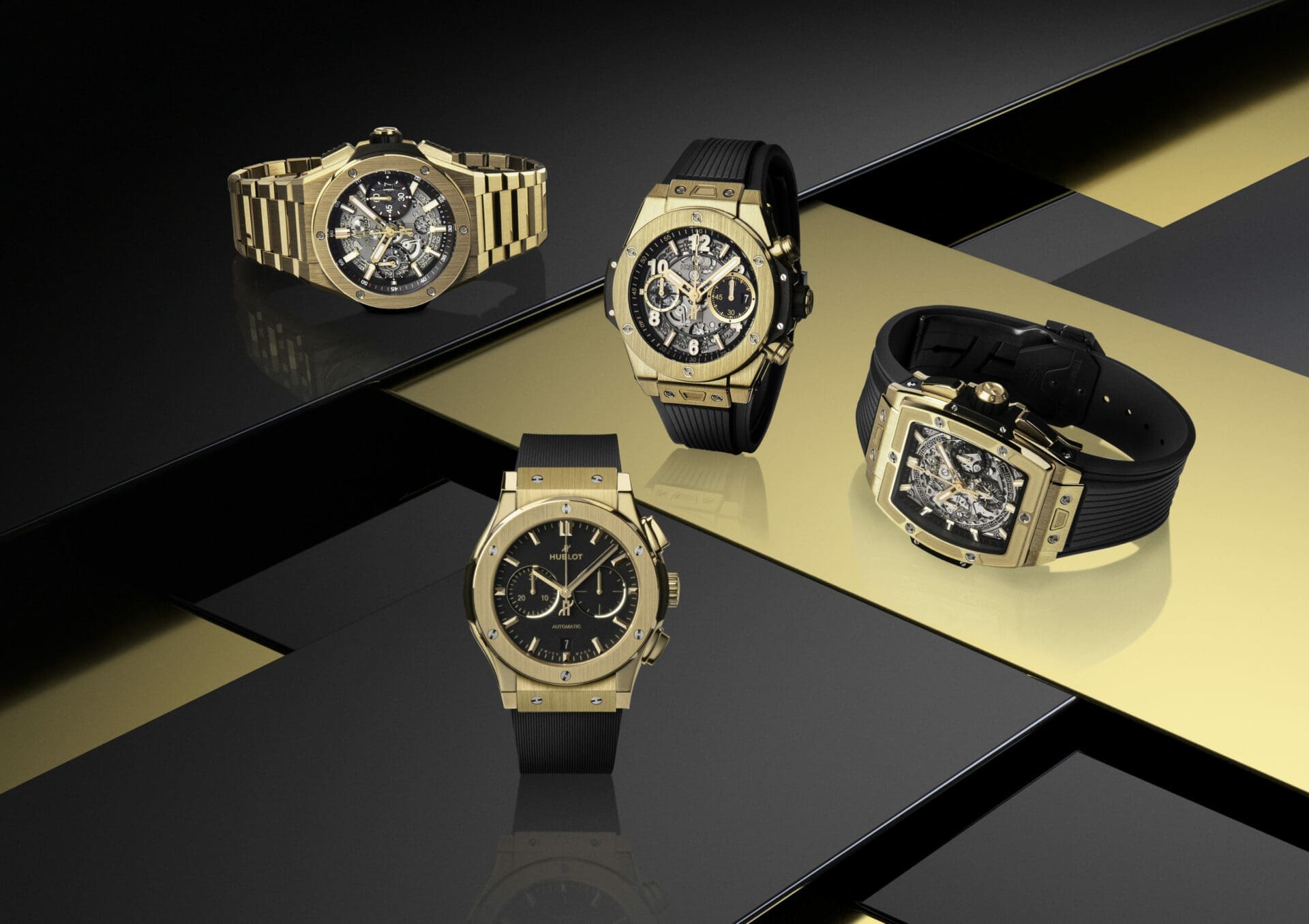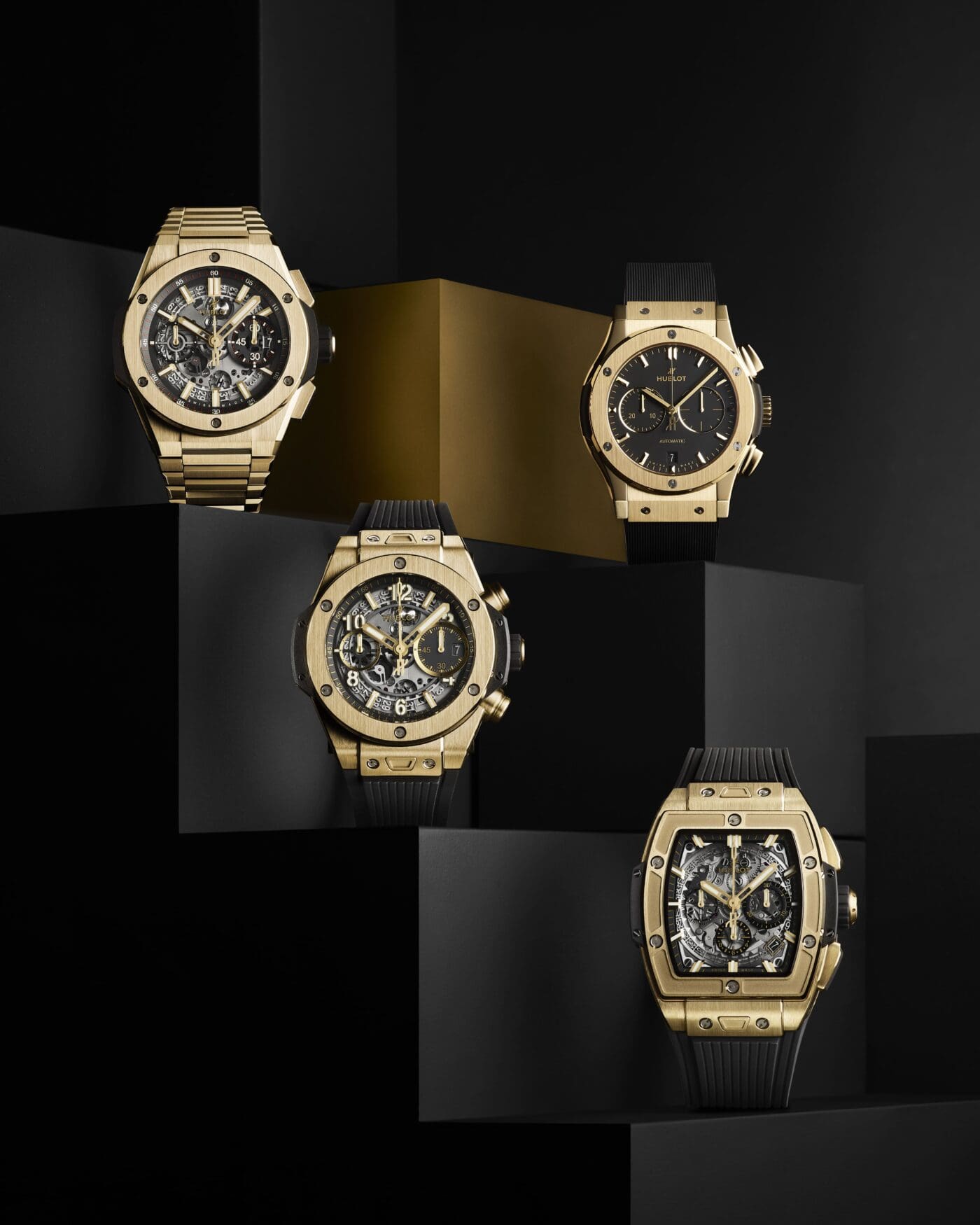The Hublot Yellow Gold collection is a return to the brand’s trailblazing roots
D.C. HannayIt’s hard to remember a time when ultra-luxe sport watches weren’t available on rubber. Today, buyers can choose from Audemars Piguet’s Royal Oak Offshore, Zenith’s Defy, Rolex’s Daytona, and many more, but this wasn’t always the case. Pre-’80s, rubber straps were considered déclassé, far too casual for anything but a dive watch. But Hublot changed all that more than 40 years ago, when Carlo Crocco released the “Classic” in yellow gold, establishing the design language from the start, with the distinctive screws circling the round bezel, as well as the hooded lugs, and yes, a high-end natural rubber strap. The look resembled a ship’s window, and appropriately, Hublot translates from French as “porthole”. The sheer audacity of a gold luxury watch on rubber was ahead of its time, however. Hublot did not make a single sale at its Baselworld debut, but got the last laugh when customers turned it into a hit. Since then, Hublot’s product range is produced in almost every material you could conceivably build a watch from, including steel, titanium, carbon fibre, coloured ceramic, platinum, and proprietary alloys like their patented scratch-resistant Magic Gold. But the newly launched Yellow Gold collection is a return to their origin story, and the material that made them the choice of footballers (and ballers of all stripes) the world over.
Hublot Classic Fusion Chronograph
This is the one that hews closest to those original Hublot designs. A bicompax chronograph, this is one of the more low-key designs from Hublot, but believe me, it’s no wallflower. The 42mm yellow gold case sports the iconic Hublot aesthetic with its hooded lugs and porthole bezel, both secured with those distinctive H-screws. Finishes alternate between satin and polished, with a layer of black composite resin sandwiched between bezel and case. The dial is pure menace, in an understated matte black with gold hands and indices, and resembles nothing so much as the classic Formula One livery of the John Player Special-sponsored Lotus cars of the ‘70s and ‘80s. Two chrono dials reside at three and nine, and the date is centered at six. The strap is crafted in that luxurious black natural rubber, and employs a yellow gold and black titanium deployant clasp. Timekeeping falls to the HUB1153 automatic movement, with a rate of 4Hz and power reserve of 42 hours, on display through the sapphire caseback.
Big Bang Integral
Hublot has joined the integrated sports watch parade, and this one has a great organic flow between bracelet and case. And that bracelet is the Big (Bang) Story here. A nice mix of brushed and polished surfaces, the links have faceted edges and resemble, of all things, little gold bars. Very Bond villain. The diameter is a substantial but not overwhelming 42mm (also available in a 40mm size), but a tidy lug-to-lug keeps things wearable. The case retains all the classic Big Bang DNA, with the protruding porthole atop the angular case. The matte black skeletonized dial features applied gold indices, and matching hands take care of timekeeping business. The Integral is another bicompax chrono, but features an in-house MHUB1280 Unico column wheel flyback calibre, visible via the sapphire caseback. Power reserve is a long weekend’s worth, at 72 hours.
Big Bang Unico
Now this is the Hublot look that blasted into the collective consciousness back in the Jean-Claude Biver heyday of the early 2000s. Thankfully, its 42mm case size is a bit more manageable than some of the rather outsized offerings in the lineup. And hard as it is to believe, this is the very first Big Bang model in yellow gold. An edgier case than the Integral’s, with a thicker blacked-out midsection, this one’s ready to party, more Ibiza than Madrid. Specs are much the same as the Integral, including the flyback chrono movement, with the exception of gold dial accents replacing the red of that model’s, making for a flashier, more athletic look. That sporting attitude is helped along by the flexible ribbed black rubber strap, secured with H-screws and a beefy gold ‘end link’.
Spirit of Big Bang
Yet another Big Bang, and although this one also clocks in at 42mm, it’s a bigger Bang because of that tonneau-shaped case. If you like to stand out in a crowd, or just want something other than the conventional, you’ve found your watch. I especially dig the bezel, with its bead-blasted recesses, a cool bit of detailing. The dial is again skeletonized, but the payoff here is gawking at the HUB4700 calibre chronograph movement, which is based on the El Primero 400, and skeletonized by Hublot. Power reserve is 50 hours, and all that mechanical decadence is yours to enjoy through the sapphire caseback. Strap game is the iconic rubber with gold/titanium clasp, and helpfully includes the Hublot ‘One-Click’ attachment system for simple strap changes.
Hublot has come a long way from their non-starter Basel debut in 1980. The new Yellow Gold lineup is a return to their roots, and the decision to pair gold with black accents and straps is a judicious one. It’s a classic look that never goes out of style, and there’s a model in the Yellow Gold range for just about any taste.
Hublot Yellow Gold Collection pricing & availability
The Hublot Yellow Gold Collection is available now
Classic Fusion Chronograph – $26,800 USD
Integral Yellow Gold – $52,500 USD
Big Bang Unico – $36,700 USD
Spirit Of Big Bang – $40,500 USD
More info at www.hublot.com










